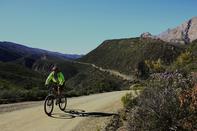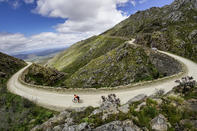A Grinding Ride
Well over a century ago, when master road builder Thomas Bain first surveyed the Swartberg Mountains before starting construction on the ‘grandfather of all passes’, he faced one major obstacle: ‘The unavoidably steep gradients of the Zwartberg range’. He may have muttered to himself in 1879, but it holds as true today…especially if you are on a mountain bike!
Many a rider has braved the Swartberg Pass en route to Gamkaskloof, and once past the poort on the Prince Albert side, a war of attrition with gravity awaits. Grit your teeth as you pedal ever skywards, engulfed by the fantastical rock strata shaped during the Devonian Period nearly 300 million years ago.
Whether you are on a bike or not, this remains one of South Africa’s most spectacular passes, and it stands today as a testimony to the vision of the brilliant Bain. Just beyond the apex, the road to Gamkaskloof turns west along a grinding ride into ‘Die Hel’ – a tortuous journey into a fertile valley where an isolated farming community prospered for nearly a century.
Donkey Trail
The word ‘Karoo’ comes from the Khoi Karusa, a term referring to a ‘dry and barren thirstland’. Despite its intimidating moniker, Die Hel is pretty fertile, with a stream meandering along the valley. This is the Karoo like you’ve never seen it before, and with a thousand things to do and see.
There is also a fantastic hiking route that you can opt for called the Donkey Trail. This hiking route follows the original trail used by Gamkasklowers to get in and out of Die Hel. Although sold as a slackpacking trip (the long-suffering donkeys will carry your heavy pack), there are some challenging mountains waiting in the wings. The trail takes four days to complete, with three glorious nights spent en route (one of them outside, under the starry skies).
All donkeys used in the project are rescue animals and now live a first-rate life. Total distance covered on foot is approximately 26 km; expect the gradient to be moderate to strenuous, but don’t worry, no rock climbing is required. You had better be fit and healthy, though, as is to be expected when tackling an adventure like this.


 The remote valley of Gamkaskloof was originally inhabited by farmers in the 1830s, and was accessible only on foot before the pass that road...
The remote valley of Gamkaskloof was originally inhabited by farmers in the 1830s, and was accessible only on foot before the pass that road... Hidden inside a narrow valley, folded away within the Swartberg Mountain massif, is Gamkaskloof. Literally, this translates as ‘Lion’s R...
Hidden inside a narrow valley, folded away within the Swartberg Mountain massif, is Gamkaskloof. Literally, this translates as ‘Lion’s R...